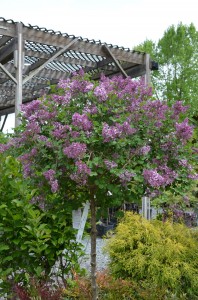Dwarf Korean lilac (Syringa x meyeri ‘Palibin’) forms a dense multi-stemmed deciduous shrub, 4 to 5 feet high and 5 to 6 feet wide, with rounded top or canopy (USDA hardiness zones 3-7). It branches low to the ground.
Flower buds form which are distinctively violet in color. In mid-spring this diminutive lilac is covered by billowy panicles of fragrant purple flowers. Trusse are excellent for cutting and enjoying inside the home for their color and fragrance. Spring foliage first arises burgundy and becomes dark green all summer long.
Palibin lilac maintains its neat and tidy compact form. Plant in full sun and a well-drained soil for best flowering annually. Initial growth rate is slow and under proper care, specifically annual feeding and pruning, will prosper for 25 to 30 years. It then may need to be renovated by pruning.
Compared to other lilac species (Syringa spp.), Palibin leaves are smaller and the overall shrub offers a fine texture appearance. The small pointed leaves do not develop an appreciable fall color. Smooth gray bark and fruits (seed capsules) offer no ornamental value.
This low maintenance shrub should be grown primarily in full sun. It is very adaptable to both dry and moist sites, but not in standing water. It is not sensitive to soil type or pH and leaves tolerate urban inner city conditions. Wait to prune a month after spring flowering to avoid removing spring flowers. Palibin is a good choice for attracting butterflies.
Dwarf Korean lilac can be utilized as a single specimen shrub or group as short hedges or privacy screens. It also may be nurtured in a large container for several years. Foliage is highly powdery mildew resistant on landscape sites with good air movement. As the above photo depicts, nurseries are now training Palibin lilacs into small compact trees.


 Posted in
Posted in 
